
Heading over the Severn Bridge on the way to Aggy. Photo by Dan Rose.
And thank you to all the people who rushed to examine their copies of the Summer 1974 newsletter to see if anyone could supply the missing words from the bottom of the page about the presidential through trip of Pollnagollum-Polleva at the age of 75. Sadly our collective investigations have concluded that all the copies are basically the same, give or take a couple of millimetres, leading us to the inescapable conclusion that there was a production fault at the time that went uncorrected in the next issue, and the missing words are now irretriveably lost.
We did better, though, with our appeal for photos of Oliver Lloyd and Trat. Many thanks to Tim and Pat Hill, Kit Easton and the cohort of cavers from the late 1950s and early 1960s who still meet for a dinner every year. Thanks to them, we have gained a photo of Lloyd and Trat together, which now graces the grants page of our website as well as several other photos of past trips to Co Clare. Amusingly, Kit commented that it had been hard to find a photo of Trat without a pint in his hands, proving that some things never change! Kit has also supplied several stories for our 100 Memories project, so look out for these in future issues.
In this issue, you'll see that digging fever has gripped UBSS again, with members burrowing underground like steroidal moles, while others have turned to the more genteel pursuit of fame and fortune through literary endeavours with a story of adventure (and cheese) on a expo to one of Europe's lesser known regions.
We're open to write ups of all your caving trips and other adventures (and we'd still like more photos of camels!), so do set fingers to keyboards, or even pen to paper! We'd love to hear from you. And although our earlier production schedule this month has meant we have some articles to hold over to the June issue, that doesn't give anyone an excuse to rest on their laurels.
If you would like to check out previous issues, you can find them all here, including the scanned archive of all our paper issues.
WARNING - BROKEN LADDER The Council of Southern Caving Clubs (CSCC) has issued the following warning of a broken ladder on the Southbank Round Trip in Eastwater Cavern. The ladder down the slope, after the second pit, leading to the balcony overlooking the Chamber of Horrors has broken. The right-hand wire has snapped and the ladder is not safe. Please do not use it and take your own equipment to tackle the slope. |

Left to right: Ben Edwards, Tom Phillips, Jess Brock, Isaac Neale.
... Attborough Swallet. As you'll see, Jess Brock is starting at the beginning. Does anyone else fancy working their way through Mendip caves in alphabetical order?
The first cave in Mendip Underground is the most Mendip cave on Mendip and it's potentially more muddy than Fishmonger’s Swallet!
It didn’t take long for us to find the in situ ladders (none bigger than a metre). They were all superfluous. A cross between a dig and a tight meandering crawl, this muddy swallet is like being birthed over and over. Fairly quickly, though it feels like forever, while wiggling through the tight passages, you drop into a pot. Think of it as a muddy human fly trap. There’s a scaffold bar perfect to hang a sling from - though this was the one place in the cave an in situ ladder would have helped!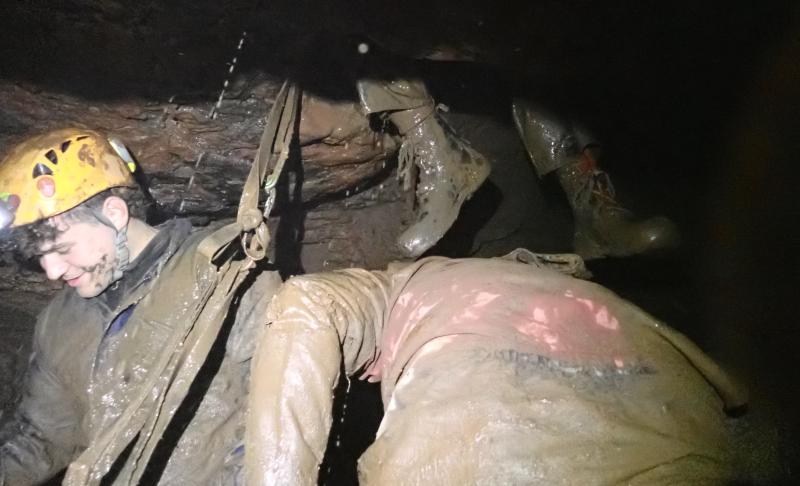
Isaac's majestic leap out of the muddy fly trap pit.
We each had a lark trying to jump out of this small pit, make a 90 degree turn and crawl back into Nasty Nasty. Several projectile methods were attempted. Isaac standing on Tom’s back was very effective. I was thrown like a rugby ball by Ben Edwards and Tom which was even more effective! All in all an easy wriggly jaunt down another of Mendip’s finest.
This coincides with the year Sir David Att(en)borough turned 99, though the only creatures he would find interesting in this cave are sweaty little muddling cavers!
Jess Brock
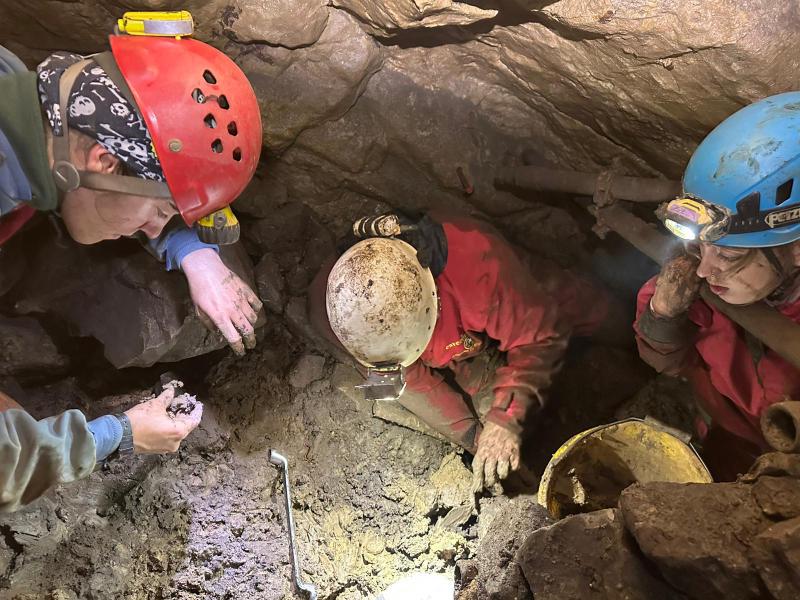
Left to right: Mungo Palmer, someone in a white helmet, Grace Smith. Photo by David Hardwick.
11th May, the day of the eagerly anticipated archaeological dig, dawned bright and fair as 14 UBSS members and some of Cardiff’s finest archaeologists gathered together for a day of fun and work below the surface. Dig Secretary Mowgli presents the next exciting episode of Fishing for Answers, a joint UBSS/Hades Caving Club/Amgueddfa Cymru production.
Digging In, Digging Down
First up, after some greetings, was a briefing from Dave Hardwick (UBSS/Hades). Keeping it short and sweet, he ran us through the pulley mechanism ("The krab stays on the rope!") and jobs we might find ourselves doing in the underland. Next up, Adelle Bricking (UBSS archaeologist) talked us through some of the previous finds from past digs. She also explained that once buckets from below reached the surface we would begin carefully working the sediment through a system of gentle prodding, poking and sifting to see if we might find something of archaeological interest like bone and pottery ("You'll also find a lot of sticks and stones!").

Adelle (left) briefing the assembled masses. Photo by David Hardwick.
Then it was time to kit up and, faff dutifully acknowledged, I found myself at the entrance to the cave. One awkward shuffle on my back later and I was in. The cave mouth quickly turns into a long shaft requiring an easy climb down to reach a small chamber where the first sign of digging appears. A scurry down some scaff and into the site of a dig you drop.
Mungo, digging that day, recalls that the original plan for the site was to excavate the floor of a section of cave near the base of the scaff. Some hard labour later a pile of larger rocks had grown and it was decided that these should be used to strengthen the floor in a separate part of the dig chamber to make it less of a mud slip and slide. Whilst shifting some smaller rocks out of the floor, a surprise cache of bones was unveiled. This was very exciting. With each new rock that got pulled out in the hours before lunch, more bones and fragments were unveiled to the diggers. Some of what was discovered was recognised by Hannah (a dentist and archaeologist) as dog teeth, in keeping with many previous discoveries from the site (now part of the UBSS Museum collection). A harder identification from humans than you might think after a couple of thousand years.
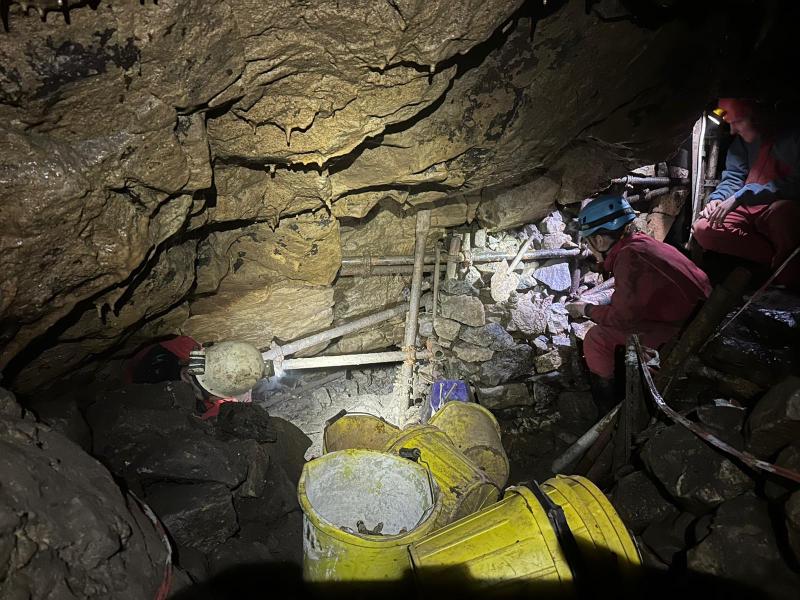
Buckets just waiting to be filled! Life at the sharp end. Photo by David Hardwick.
Also on hand was George from Cardiff University’s Archaeology department, so the diggers felt no shortage of expertise. Dave oversaw the digging muscle all day ("Remember, the krab stays on the rope!"). The decision was made to stop the efforts before lunch and before too many of the bones were removed from this surprise cache so that some of the others could get a chance to see them before they were dug out. Hunger might’ve played a role in this, too. Even old bones start to look edible after a few hours underground.
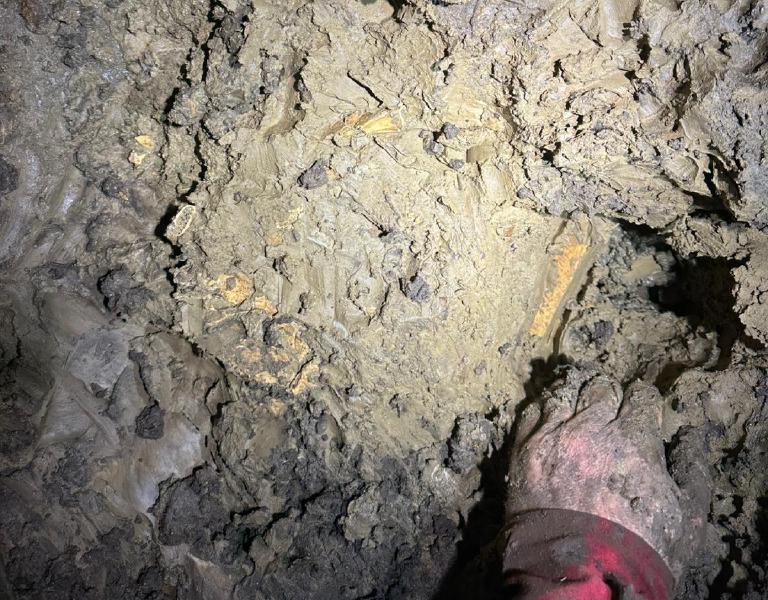
Look what turned up just before lunch. Photo by David Hardwick.
The cavers had a merry lunch, celebrating Dylan’s birthday on the lawn of the Manor House with a ritual Colin the Caterpillar cake. Spirits stayed high going into the afternoon, which bought a changing of the guard down under. Archaeologists and a new batch of cavers went in, Bones and spoil came out.

Life on the surface. Children who like playing in mud grow up to be adults who like playing in mud!
I spent the afternoon mostly above ground, working on my tan whilst gouging through the muddy buckets in absolute delight. The archaeologists above ground were extremely good natured and patient with the regular shouts of “bone” which on closer inspection often turned out to be sticks. But we did find plenty of real bone, including a large fragment of a human cranium as well as several Iron Age pot sherds.
What's Next?
Adelle will clean and examine the finds further, bagging and tagging as she works. Once this is completed the bones will make the leap back to the UBSS museum to join the rest of the material from the site.
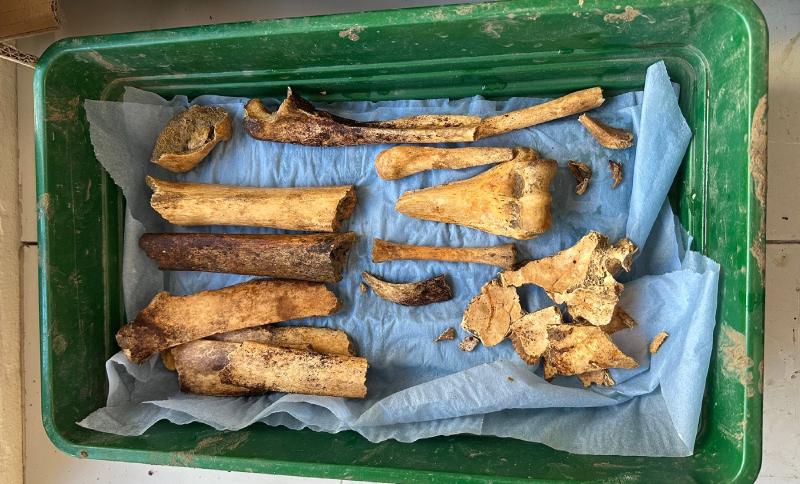
Above are the finds from the 'big bone bag' excavated from the clay deposit in Skull Sink in Bone Idle Chamber: human tibia shaft, distal tibia epiphysis, ulna, humerus, cranium, plus some animal bone.
The brown tibia shaft fragment (left centre) has been chewed quite extensively by dog(s). When asked if the finds were consist with previous work at the site, Adelle provided this off-the-cuff summary: "Yeah, people with bad teeth dying of various infections/tick born illnesses and/or getting whacked, at some point their bare bones are made available for dogs to chew on, eventually everyone ends up in the swallet." She added: "The loose tooth I found today was very worn, so an old person again."
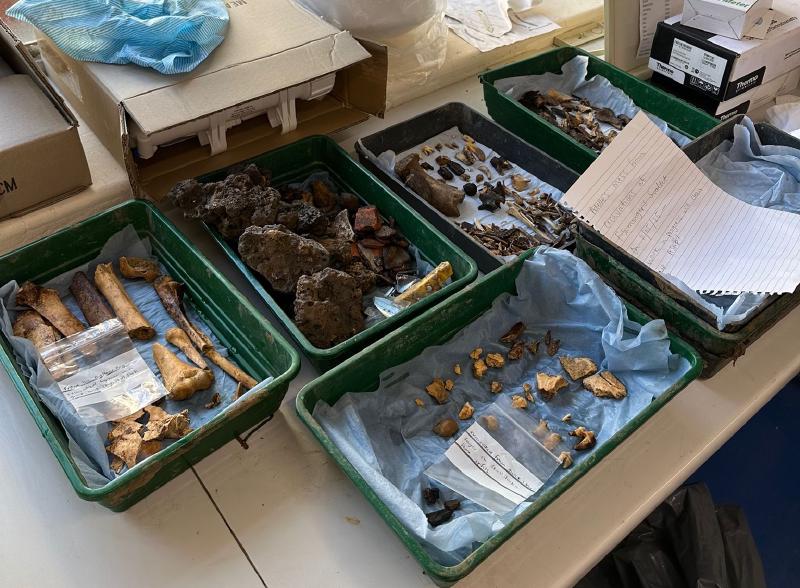
Work in progress on the various specimens!
The Team
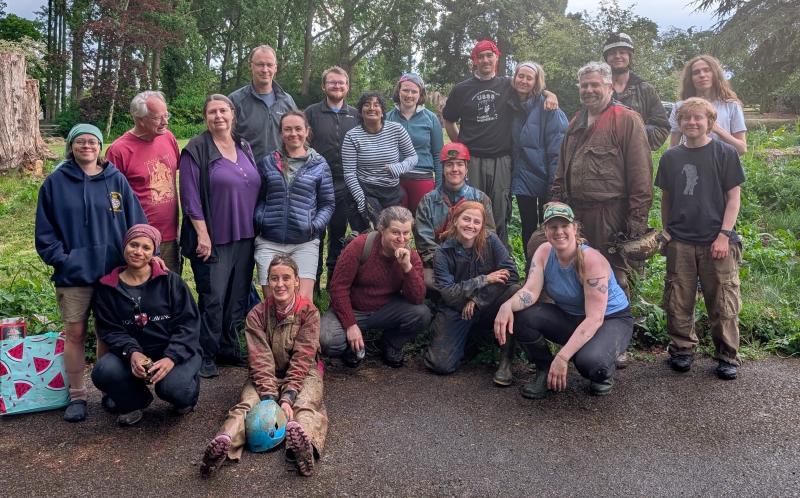
(Back row, left to right) Jess Brock, Jack Randall (Hades CC), Andy Farrant, Chris Griffiths*, Hannah Slater-Patterson*, Billy Evans, Emily Wormleighton, Mowgli Palmer, Ash Simmons-Hall; (middle row, left to right) Linda Wilson, Marie Chapman, Moon Devendra, Mungo Palmer, David Hardwick, Dylan Toomey, (front row, left to right) Joshitha Shivakumar, Grace Smith, George Whatley*, Adelle Bricking*, Lindsey Sartin*. Also present for part of the day were James McMillan-Kline, Jan Walker, Jo West, Graham Mullan, Stuart and Cayley Alldred (with Jasper and Rupert), Sally Donovan* and Mark Lewis*, the curator at the National Roman Legion Museum at Caerleon. (* denotes involvement with Amgueddfa Cymru/Museum Wales.)
Thanks!
A big thank you from UBSS to all the archaeologists, cavers, family members and the community that made the dig a success.
A special thanks goes to Dave for his organising and caving prowess and to Linda for her generosity and admin bossing. A final thanks goes to the landowners who welcomed us, and continue to show such an interest in our activities at the bottom of their garden.
Finally, to those who want more digging, there’s plenty more going on if you ask me or request to be added to the dig WhatsApp group and we will find you some!
Long live UBSS.
Long live the Dig.
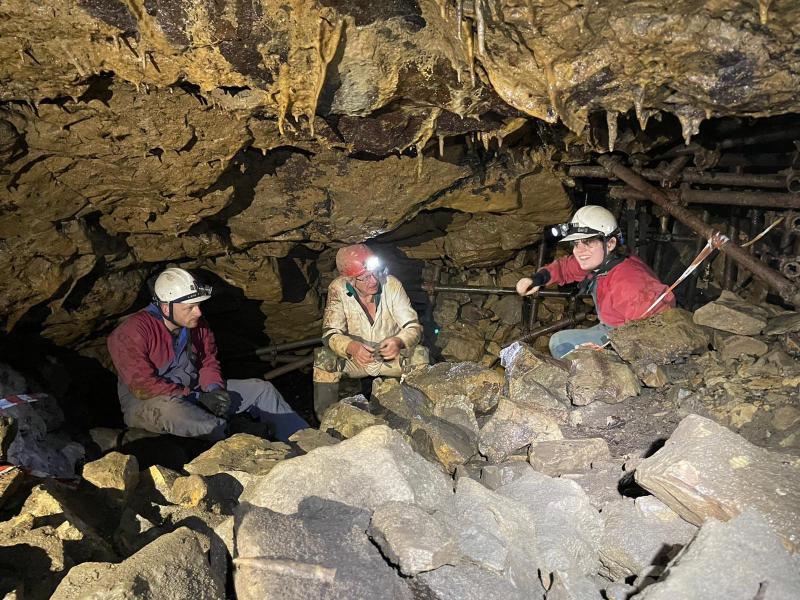
Left to right: Richard Madgwick, Jack Randall and Jessica Peto in Bone Idle Chamber.
A human jawbone from Fishmonger's Swallet housed in the UBSS museum has contributed ancient DNA to ground-breaking research into bacteria.
The jawbone was one of four samples from across the UK, ranging from 2,300 to 600 years ago, that helped researchers at the Francis Crick Institute and UCL in London use ancient DNA to pinpoint the evolution and spread of Borrelia recurrentis, a type of bacteria that causes relapsing fever.
Fishmonger’s Swallet has yielded an astonishing amount of material from the Iron Age, including people and dogs radiocarbon dated to the late pre-Roman Iron Age between 200BC to 35BC.
The research is published this week in academic journal Science, with UBSS members Adelle Bricking, Linda Wilson and Graham Mullan as contributing authors.
Until now it was not known when B. recurrentis made the jump from ticks to lice and what impact this had on disease transmission and severity in humans.
Researchers concluded that the evolution of B. recurrentis highlights that a combination of genetic and environmental changes can help pathogens spread and infect populations more easily. This transition may have coincided with changes in human lifestyles, like living closer together and the beginning of the wool trade.
References:
Francis Crick Institute press release.
Darkness Below.
PS Couldn't resist the clickbait headline, especially not after the recent UBSS outbreak of tiny, scratchy pets.
Following the warning of a loose boulder in last month's newsletter, a call has now gone out for volunteers to help with stabilisation. This is a good opportunity to work with other local cavers and to give something back to the caving community.
Last year it was noted that a large boulder between Butts' and Upper Butts' Chamber had moved approximately 1mm. Earlier this year it was noted that there was no change and the gap remained at approximately 1mm. However, during the Easter break a further inspection revealed that the boulder had moved significantly and the gap had opened up to approximately 40mm.
A further trip on the 30th April by Wayne Starsmore and Dave King assessed the boulder and looked at possible options. Various options were discussed including: bring it down, install steelwork, do nothing. These option were soon dismissed and it was felt the most appropriate plan of action would be to fill the cavity beneath the boulder to give it a good foundation.
Volunteers are required on Saturday 21st June to assist with the following:
- Ferrying in cement, Postcrete etc. via Hobnail Hole.
- Chain gang to pass rocks up in Butts' Chamber.
- Mixing cement/mortar.
- Filling the cavity beneath the boulder with rocks and cement mortar etc.
In addition suitable containers are requested to carry supplies in ie old BDH containers and tackle bags.
If you are able to assist in any way please contact Dave King.
Thanks in advance.
Dave King
07770923407
[email protected]
SZ

Survey extract to show dig location in red circle.
As Digging Fever grips UBSS (again), Dan Rose, Ben Morgan and Billy Evans have joined the attempt to connect two of South Wales' major cave systems. Dan waxes lyrical on their work at the sharp end.
Midway through the tropical paradise of the 2025 Spring, having spent far too long enjoying the Bahamian sunrays and warm wind currents, Billy, Ben and I spotted a post on UKCaving calling for anyone with ‘a pair of arms’ to assist in the rapidly developing Donovan’s Grief dig in the hope of connecting Agen Allwedd and Daren Cilau; probably mine and Billy’s favourite cave, where some of our fondest memories of first year were made, so the prospect of continuing the 40 year effort to double Daren’s size and create the third longest cave in Britain naturally piqued our interest.
Thus, on the glorious Friday evening of the 11th April, we set off to Whitewalls, passing through a Bristol more reminiscent of Los Angeles’ Muscle Beach than British West country; the Severn Bridge basking in the solar flames of Mordor, its metal shining in flowery vaporwave psychedelia. Channelling Pearl Jam’s Even Flow, we skid up the tarmac hairpins of Llangattock and approached the doors of Whitewalls, where so many memories – from euphoric to traumatic – had been hammered into our souls on weekends before.
A quick change in twilight acquainted us with the resident Priory Road pushers: Alex Stacey and Andrey Kozhenkov. The walk up had Alex explaining in precise detail the developments of the dig since the 1980s, from high to low, hope to pitfall, and why this time it was guaranteed to go, so long as 20 or so weekends were dedicated to soothing Donovan’s Grief – the allegedly smoke tested lead that, with enough cap and haul, would lead to the far reaches of Daren Cilau, and create a 60km system that, although smaller in length than Draenen and OFD, would, due to the strenuous, varied and awesome nature of its passages, feel colossal.
After some amusing comparisons with Llangattock to the tunnels of New York City, we slid into the entrance and sped onto and through Southern Streamway, brute forcing tackle sacks of camping kit and peli cases of capping gear through the irritating passage induced a flow state of mild amusement, with the soundtrack of clashing plastic, dripping water, and Alex’s impressive stock of pre-packaged jokes. As ever, Southern Streamway’s enjoyment is inversely proportional to your level of mental presentness. When alert, sensitive to your surroundings and conscious of the cave, it’s an annoying slog, requiring uncomfortable stooping and unwelcome cold-water crawling, difficult enough to require at least some cognitive engagement, but easy enough to be continually boring. Last year it tried to kill me, when six rocks fell – completely spontaneously - from far above onto my head and neck, out of an area inaccessible and untouched by humanity. Upon this revisit, I tried to remember to forget that one occurrence.
When mentally separated from the stream, however, it becomes barely noticeable. I, for one, enjoyed the streamway, taking it as an opportunity to reflect on Olaf Stapledon’s Sirius – a science fiction book about a sentient dog that I had read the summer prior – while traversing the streamway on unbothered autopilot. What would Sirius think of Llangattock? A place of pleasure or pain? A site of solitary reflection; the resolution of the tension between the animal spirit of the dog and the human reason of sentience. Canine catharsis.
Before long we reached the turn off point for Priory Road, where we filled up a few gallons of water for the camp and snaked through the increasingly Daren-esque passages of Eastern Aggy. A couple of free climbs and crawls later we had arrived at the camp, and what a lovely camp it is. Never before had cave-camping felt so cozy. Where Hard Rock Café reeks of debauchery and mould, and Restaurant at the End of the Universe strangles the camper with dark voids of desperate desolation, this Aggy camp feels like a warm embrace. Think County Clare fairytale cottages. A padded common area situated under a chandelier centres a draughtless passage with back shaped rocks and warm tents. Pleasantly surprised by the conditions, we promptly dug into our grog and embraced the innate human joy of alcohol intoxication.
The following morning we rose, regretted our 4am bedtime and winced at the peeling on of wet undersuits, firming the sandy shingle and plodding down to the dig site. On the way we passed the Courtesan, probably the second finest formation under Llangattock; an enchanting upside-down Christmas tree of electric helictites, dancing in intricate patterns away from its trunk. It’s a work of art, and contained within a chamber covered in helictites that in any other place would form the first attraction; some phallic, some not. Shortly after the Courtesan we reached the old camp that was used in the 1980s. Here, unopened marathon bars and packets of 20th century Walkers crisps remain sitting on cairns, beside old lighters and bits of bang.
We crawled into the bendy passage of Donovan’s Grief up to the dig face and formed an assembly line of spoil removal with Andrey capping at the front. With each bang split boulders would be slid between us on a drag tray attached to a rope on a pulley system. In this position we lay for ten hours, dragging rock after rock, cap after cap, motivated by our love for spoil, the excitement of the system, and the swing of Dire Straits. ‘They call me the spoil whisperer,’ I uttered in profound delusion, cradling the crumbling geology against my chest and lifting it into the drag tray, then signalling for it to be carried off before covering my ears and bracing for the bang of a nail gun cartridge.
Late in the day, after a full day’s digging, although exhausted, we visited another dig in Isles Inlet where Ben and I emulated First World War trench tunnellers excavating a passage choked with infinite sand, hauling pile after pile into a drag tray, to be dragged out and replaced by Billy and Alex. Continual conjuring of tears to flush out my grit covered eyes finally ceased after a further two hours, when the camp beckoned us back. Weary after 12 hours digging, we finished our booze and, although we wanted to stay up and talk, our tiredness disallowed it, as we piled into tent-facilitated slumber.
The following day we caved out and raided Abergavenny Wetherspoons. We had made half a metre of progress. Only 22 more of those and the 11m separating Daren and Aggy will be passed! If it goes it will be amazing, the best cave in Britain! Llangattock, or Llangulag as I heard one person call it, is one of the most amazing places on Earth! Join the effort, and haul spoil! The Aggy-Daren supersystem needs you!
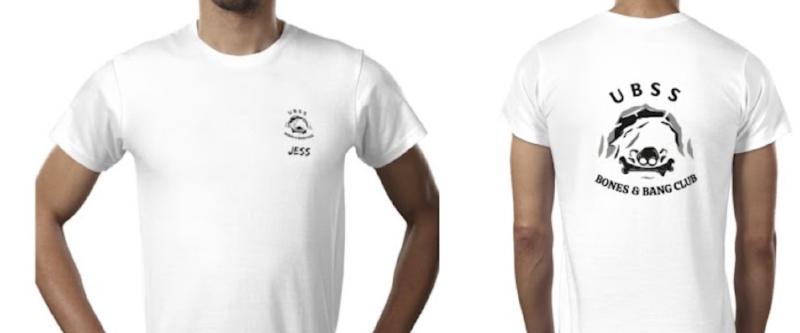
Due to the newfound popularity of digging as an activity, Jess Brock has designed a teeshirt for keen diggers.
If you'd like to order your very own digging teeshirt, complete this form immeditately, as the order will be going in just after this newsletter hits your inbox and then await payment instructions for the £16. Remember, your order won't be confirmed until payment has been made, so no money means no merchandise!
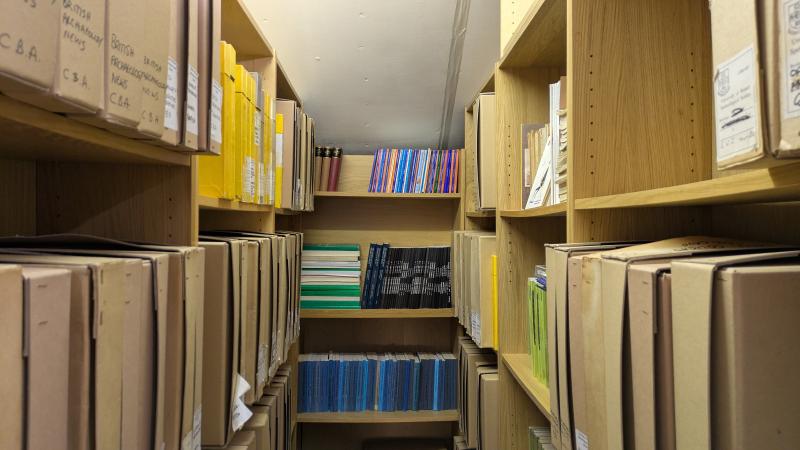
After near four years of contant disruption. the UBSS library stack room has been restored to order!
Thanks go to Graham Mullan for organising this work,and to Moon Devendra, Lee Okoh, Grace Smith, Mowgli, Dylan Toomey and Naomi Conway (who offered to help out when she met Linda at a recent Bristol Museums' Group meeting).
After several hours hard labour, many many boxes and books have been reduced to order and a location plan has been drawn up to help users.
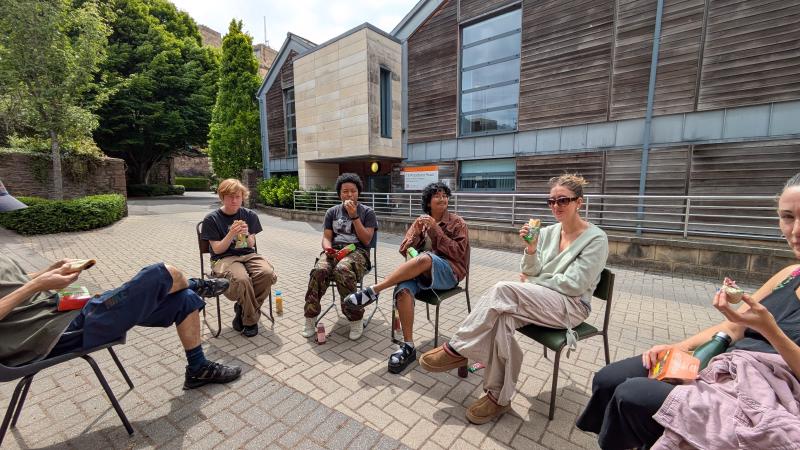
A well-earned break. Left to right: Mowgli, Dylan, Lee, Moon, Grace, Naomi.
Now this has been done. the next job to tackle is four years' worth of accumulated filing.
Volunteers needed again, please!
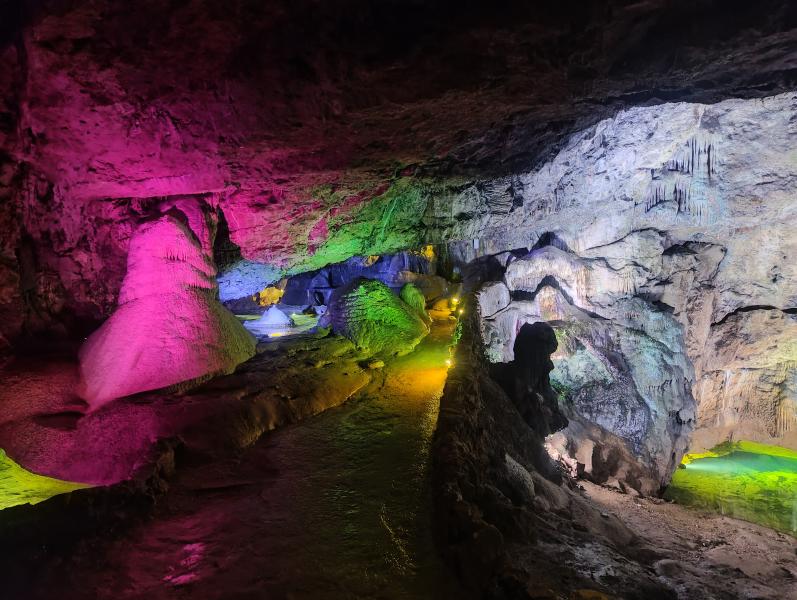
Chamber 1, Wookey Hole, with the 'Witch of Wookey' in silhouette.
Jess Brock now has not just one dream job, but two!
It’s fair to say I have been caving a while. I’ve even ventured into a few show caves over the years. But nothing quite compares to working in the three most popular showcaves in Mendip (perhaps the only?). Stepping into the working world, I didn’t stray far from my underground roots. Instead of caving for fun, I now spend my days like a vampire hiding from the sun working at Gough’s Cave and Cox’s Cave in Cheddar Gorge and Wookey Hole in Wookey.
Yes, that’s a lot of caves.
Yes, that’s an hour commute from Bristol (each way)!
Yes, it is absolutely brilliant.
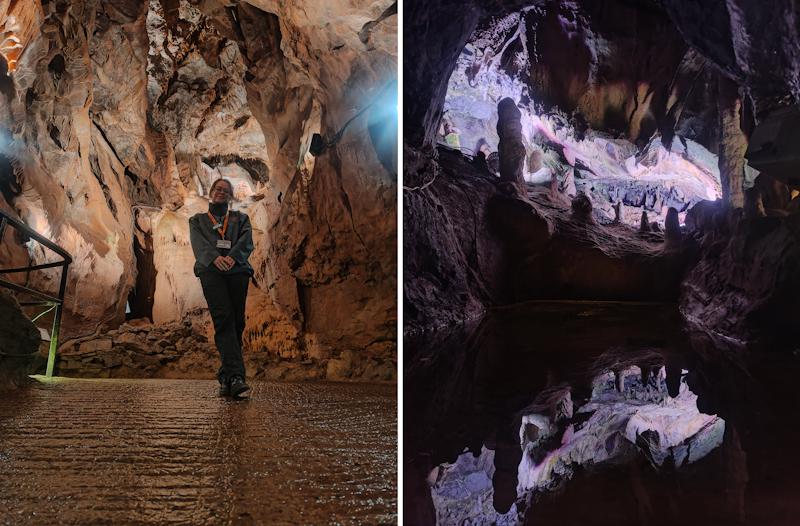
Left: Jess hanging out in the Diamond Chamber, Gough’s Cave. Right: A room with a view in Cox's Cave.
Working in the show cave world has opened up a whole new fascination for me, particularly in geology and prehistoric life. As a caver, it’s easy to be awestruck by delicate curtains and towering columns. But learning the science behind their formation—how they came to be, what they’re made of, and just how long they’ve been growing—adds an entirely new layer of wonder.
Where once I’d bumble through GB or any other cave muttering, “That stal is pretty cool,” I now find myself pausing in thought: “This stalagmite is nearly a metre tall, so it must be around 10,000 years old. That’s as old as Cheddar Man.” Facts like that might sound a bit dry at first, but they completely change your perspective. These caves are time capsules, filled with delicate formations that have taken tens, sometimes hundreds of thousands of years to grow—completely untouched by humans until relatively recently. We are just a blip in their lifetime.
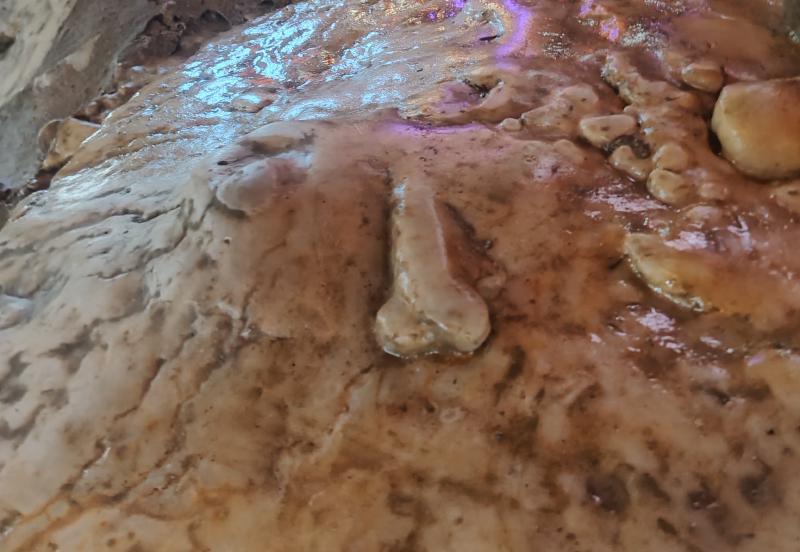
Cheddar Man's missing part. Don't anyone tell the Natural History Museum!
In Wookey Hole, there’s a column that is approximately 100,000 years old. Just 50,000 years ago, Neanderthals hunted in the valley, eating woolly mammoths and growing their hair out like true Stone Age icons. Now, I get to stand there—where they may have stood—and share stories of ancient people, geology, and folklore with curious visitors. It's humbling.
Of course, working in all three caves isn’t without its challenges. The hardest question I ever get asked? “Which one’s the best?”
Both caves are unique and breathtaking in their own way. Wookey Hole has natural beauty and incredible variety in formations, chambers and man-made elements. The caves in Cheddar are stunning and potentially win on the formation front, but they also take your breath away with their living history.
Cox's Cave was discovered by George Cox in 1837 and opened to the public in 1838. Richard Gough spent the better part of his life, from the 1860s, in charge of, firstly, Gough's Old Cave and then Gough's (New) Cave, the current main show cave. He spent eight years excavating inwards from the entrance through sediment and solid rock. His determination paid off—standing in the Diamond Chamber today, surrounded by glittering formations, it’s hard not to feel a deep sense of awe. Visitors are often amazed when I tell them everything they see was created by water and time alone. One formation in particular—the Tree of Life—is said to have inspired Tolkien’s Tree of Gondor. Each time I see it, its pristine paleness leaps out at me, and I am reminded how small we are in the lifespan of formations.The tree of life has been growing for over 250,000 years.
It’s staggering to think these places were undisturbed for millennia, formations quietly evolving in the dark—only now to be seen and appreciated by hundreds of thousands of visitors each year.
And then there’s the cheese.
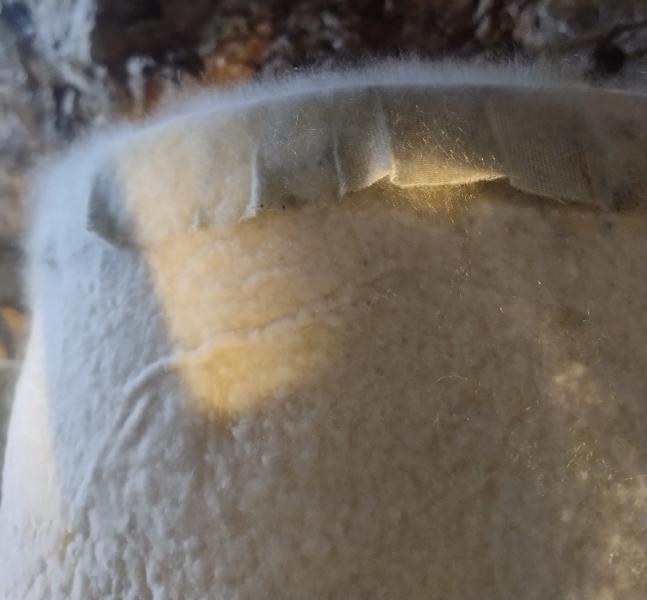
Cheese aging in Wookey Hole.
Stored deep within both Gough’s cave and Wookey Hole the cheddar enjoys constant cool temperatures of 11 degrees all year round. High humidity (almost 100% at Wookey). And a special mould that grows on them which creates an earthy and tangy flavour that melts in the mouth. There’s nothing more enjoyable than eating a cheese sandwich by the cave where the cheese was aged.
Working in these three incredible caves has completely transformed the way I view wild caving. It’s deepened my reverence for these places and reminded me of how privileged we are to explore them. In the show caves, I get to share their wonder with the public. In wild caves, I get to experience them quietly, off the beaten path, surrounded by people who truly care about their preservation and conservation.
Two new books are available from the Mendip Cave Registry and Archive (MCRA).
Firstly, the third and final volume of the highly acclaimed Mines and Minerals of the Mendip Hill by Peter Burr has now arrived.

This book augments Volumes I and II, published by the Mendip Cave Registry in 2015 and has been bound to match the previous one so as to form a three-volume set. The previous books are still available to purchase from MCRA (see below).
The series will appeal to anyone interested in the Mendips, in British geology or mineralogy, or in British mining, social or economic history. The book is profusely illustrated with 150 photographs, maps, and diagrams, and includes some 2,000 manuscript, newspaper, and literature references.
Although much has been published on the Roman mines and smelting works in the Mendip Hills, this consists mainly of unsubstantiated speculation, whereas this volume attempts to set the record straight. An overview is also given of the mines and minerals of the area immediately to the north of the Mendips and the book also covers the mineralisation at Chipping Sodbury Quarry (also known as Hampstead Farm Quarry) on the eastern edge of the Bristol coalfield in Gloucestershire. mineralisations in the Mendip Hills. A collection of photographs, together with short descriptions and explanations, provides a more graphic view of the subject. There is also an analysis of additional relevant rocks, minerals, and slags.
Cost £47 (plus £9 for UK p&p) TOTAL Cost £56
Contact or post cheques (made payable to MCRA) to -
Alan Gray - [email protected]
42, Maynard Terrace
Clutton
Somerset
BS39 5PW
Secondly, Alan Gray's A History of Mendip Cave Accidents and Incidents is available for free download.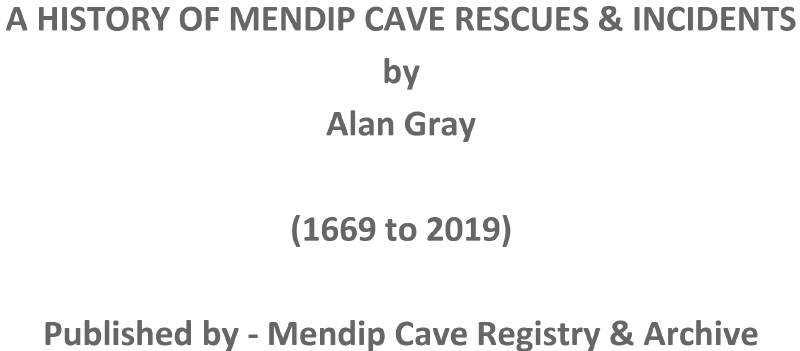
This is a detailed study, complete with photographs, illustrations and statistics from the Mendip Rescue Organisation and Mendip Cave Registry archives, covering 350 years of incidents from 1669 to 2019. The 15 MB pdf contains 767 pages.
The book provides a fascinating history of cave rescue on Mendip and how the organisation we know today as Mendip Cave Rescue started and developed. In the section on the underground incidents themselves, naturally Bristol's own Pen Park Hole features heavily, along with lesser known tales of tragedy and hair-raising escapes.
This is a book to dip in and out of rather than read from cover to cover. There's plenty here to entertain as well as horrify and it will almost certainly instill into anyone who does venture in a healthy respect for what can - and frequently does - go wrong underground. So never forget the most important rescue technique of all - that of learning how not to get into a situation that you need to be rescued from!
The free download can be obtained here.
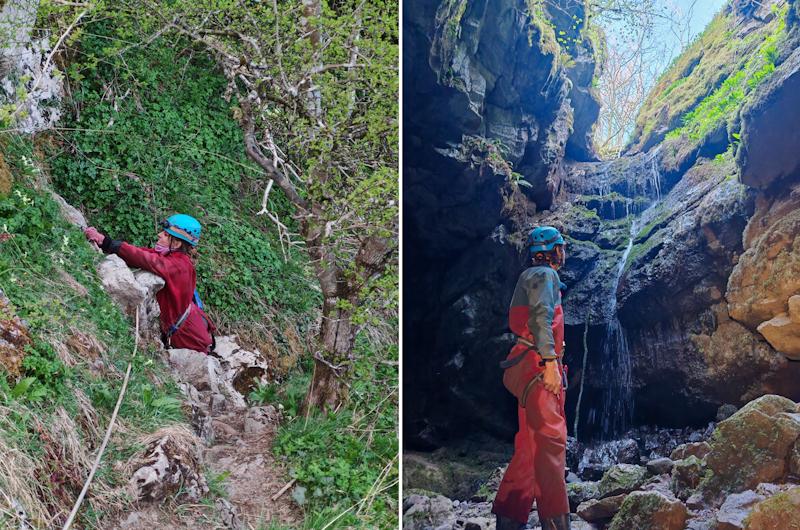
Left, Grace in the entrance pitch of Bull Pot of the Witches. Right, Mowgli in the main open chamber.
Joshitha Shivkumar tells a tale of daring and adventure far beneath the Yorkshire Hills.
Bull Pot of the Witches
Mowgli, Grace, and I got a lift to the Red Rose, courtesy of Grace’s dad. Very busy week at the hut for Easter. We met a few members of both SMCC and Southsea at the hut. We’d promised ourselves a productive start: wake up at 8am, get some revision done and head underground after lunch.
Unsurprisingly, we woke up at 10am but we managed to squeeze in some work before treating ourselves to a trip. Southsea had kindly left their ropes rigged for Bull Pot of the Witches, so we made the most of the setup. After soaking up some sun at lunch, we headed underground around 3pm. This trip was especially exciting for us as it was our first unsupervised SRT trip.
We descended via the traverse line into the cave. The entrance was quite pretty, surrounded by wild garlic, primroses, and bluebells. From there, you could see the big drop into the main open chamber.
The first pitch was free-climbable, and most of the pitches were short and straightforward with no pesky hard deviations. In total, there were four short pitches. After the second one, the passage opened up into the main chamber, where a small waterfall added to the scene. The weather outside was sunny, and shafts of sunlight filtered into the chamber, making it all the more beautiful. At the base of the open pot, we doubled back into the main passage on the left. Two more pitches brought us to the bottom.
We continued along Long Gallery, scrambling and doing some fun little climbs along the way, until we reached the downstream sump. The streamway eventually flows into Lancaster Hole but is guarded by sumps. On the way back, Grace derigged and we were out in no time.
We ended the evening with good food, lovely chats, and a bit of port generously offered by Southsea.
Day Three – Rigging Lessons and Happy Accidents
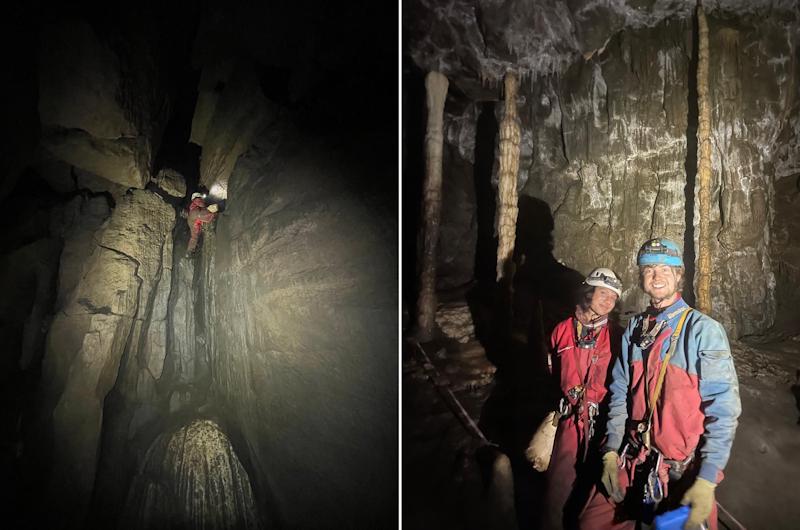
Left, the climb down into Fall Pott. Right, Joshitha and Mowgli.
The next day, we headed down Lancaster Hole. Mike Butcher took Mowgli and me underground to teach us the basics of rigging. I’d never rigged in the SU before, but I knew the basic knots so I wasn’t entirely sure how things would go.
Before we set off, Mike asked us what the key things to check before going underground were. With total confidence and zero hesitation, I said ‘Cave snacks.’ We did, eventually, add more sensible answers like description and callout.
After a bit of rigging practice above ground, we made our way down Lancaster. I rigged the two rebelays and, to my surprise, I actually found the whole process therapeutic. From there, we continued toward Fall Pot, where Mike taught us angel winging, essentially using your body as a belay on handlines. Very cool. We turned back at the knotted rope climb leading to Stake Pot. While derigging, I’d been feeding the rope into the tackle sack every 5 metres and accidentally tipped the bag upside down at the rebelay. A humbling lesson on gravity.
Mike left us some ropes for the rest of our Yorkshire trip, which was incredibly helpful. The plan (if you can call it that) was to rely on the RRCC tackle store. That didn’t quite work out as its members only. What we did have was a delusional level of optimism that everything would somehow fall into place.
And, miraculously, it did.
Happy days.
County to Wretched Rabbit – A Tour Through Ease Gill
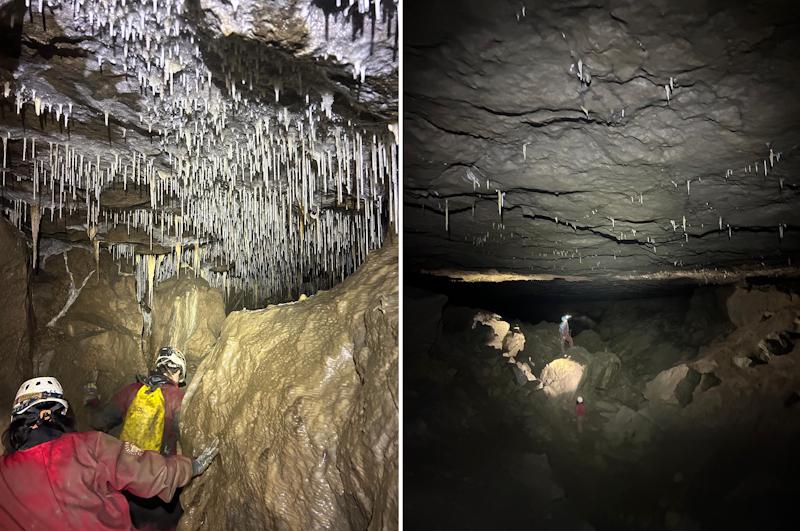
Left, Main Line Terminus Passage. Right, Monster Cavern.
The day after, David Brown took us down the County Pot to Wretched Rabbit through trip in Ease Gill. We descended the 7m entrance pitch and from there, it was fairly easy walking passages until we dropped down into Broadway. We made a brief stop at Spout Hall to try to find Poetic Justice, but after poking around a bit and getting nowhere, we gave up and returned to the main route.
After a muddy crawl, we found ourselves in the Battle of Britain Chamber. Another short crawl brought us into the chamber with the fixed ladder, which we climbed up to continue towards Brown and Smelly Chamber which actually did not have a distinctive smell. From there, we followed some steep, narrow rifts along Spangle Passage, eventually emerging into the muddy Old English Chamber. After a break and mud fight, we moved onto a small squeeze in the floor; the kind of passage you would have never guessed was the right way on unless someone insisted. It led to a long, exhausting crawl that made me wish I had knee pads.
After what felt like forever, the crawl opened up into Main Line Terminus with its very well decorated roof. We took a quick detour to peek into Monster Cavern, Snail Cavern, and Cornes Cavern. Monster was by far my favourite – huge and atmospheric. A good snack stop.
From there, we made our way towards Stop Pot. There were loads of loose boulders, and at one point, quite a sizeable rock missed landing on my foot by a disturbingly small margin. We reached the balcony overlooking the depths of Stop Pot, then climbed down the fixed ladder. After that it's all a bit of a blur. The route to Wretched Rabbit becomes increasingly mazey, and my sense of direction vanished somewhere in the mud.
Back at the hut, Kenneth finally turned up and this time with Barry the Bongo van. Barry also came equipped with a CD with multiple tracks, many of which were already part of the iconic UBSS playlist curated by Billy. We all fell in love with Barry. He’s perfect!
Winding Down, Illness Strikes and a Final Cave
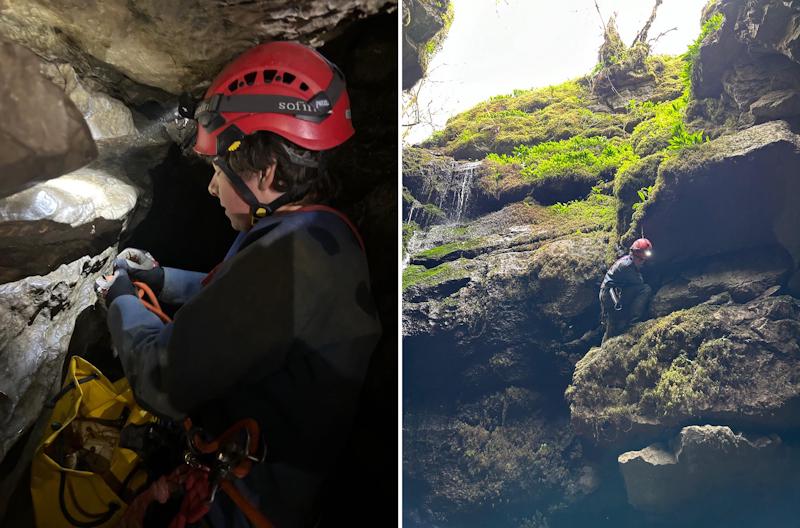
Left, Kenny rigging Bull Pot of the Witches. Right, Kenny sidequesting, as usual.
The next two days didn’t involve much caving (sadly), as we tried to get some revision done. To make things worse, Grace and I both got quite ill for a day. A real shame, especially since the sun was out in full force.
Mowgli had been the curator of most meals, with Grace and me helping out. But on Saturday, Kenny decided to take on the chef hat and cooked what can only be described as the most splendid mushroom curry. Well done. boys.
By Friday, we were determined to squeeze in one last bit of SRT practice before leaving Yorkshire. After packing up and cleaning the hut, Grace and I figured a final trip underground might lift our spirits after a day of feeling grim.
To bring things to full circle, we headed back to Bull Pot of the Witches for our last cave in the dales. Grace and Kenny rigged on the way in, while Mowgli and I were on derigging duty on the way out. We hit the road to Bristol, with a lovely stop at Grace’s for tea.

Left, Joshitha derigging Bull Pot of the Witches. Right, Grace starting the journey back to Bristol.
7 days in Yorkshire and I only wish I could be there for more.
Great caves, great company and great views. Everyone we met was incredibly generous, helping us out with tackle, leading trips, and teaching us to rig. Special thanks to whoever left us the sweet chilli sauce. Jokes aside, this trip restored my faith in humanity and made me appreciate the caving community so much more :)
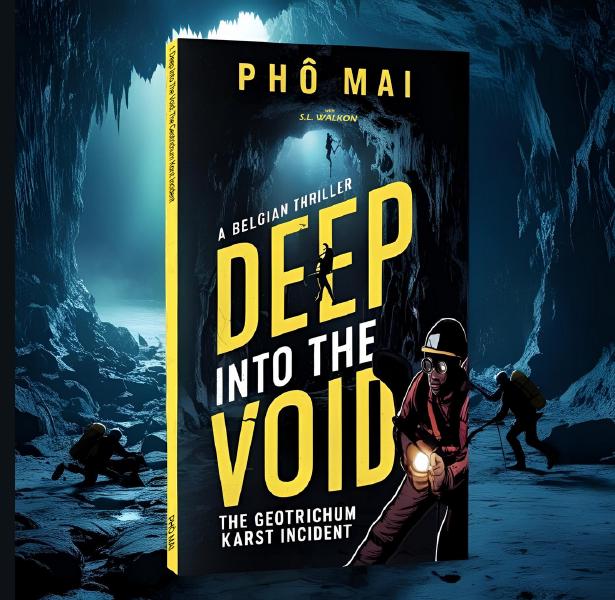
With more time on their hands than they knew what to do and student loans to repay, S.L. Walkon decided to try to make a fast buck on the literary scene, whilst pretending to be ghostwriting for someone more famous. To everyone's surprise (even their own) their puerile efforts are now the subject of a fierce bidding war between rival publishers. So here's a sneak peak at what is hotlly tipped to become the next Hugo Winner.
Chapter 1: Into the Bleu
The karst hills of Wallonia were known for their labyrinthine caves, some suitable for complete freshers, some dangerous, all utterly Belgian in their capacity to be soggy and oddly self-important while at the same time neutral and oddly dull.
Professor Olivia Witty stared down at the map in her hand, double-checking their location. She liked maps. Maps were rational. Maps didn’t reek of mildew, students’ socks and other half-forgotten nightmares. She then stared up at the unprepossessing, gouda-colored surface of the limestone outcrop the map had unerringly led them to (and Google could keep their squeaky artificial voices). She was in the right place, there was no doubt about that. The location didn’t exactly inspire confidence.
She questioned, for the third time that day, whether she should have taken up taxidermy instead. There were always plenty of (un)willing subjects to be found on campus even after the medics had done their best to reduce the overcrowding problems in the oversubscribed and over-priced accommodation …
Olivia sighed, and the vision of stuffed students vanished like sobriety at a party at the caving club hut.
Maybe she should just stick to staring at the map, hoping to find another suitable area for their research, one that didn’t come with quite so much baggage.
She pinched the bridge of her nose, a headache already building behind her eyes. It was too late for a change of plan now.
It would all be fine. All they had to do was go straight on.
The School of Applied Caseiculture’s Safety Advisor had insisted on a higher level of health and safety this year and as their Vice President, she’d turned to the Mendip University Caving Society (MUCS) aka the Underworld’s Best Bruisers (UBBs) as they insisted on calling themselves, after their successful foiling of a huge cheddar heist from Wookey Hole. She was now sure that triumph must have been completely accidental, as witnessed by the epic levels of faff she’d endured to get them by minibus from the Mendips to Wallonia. They'd already put ten years on her life and another fifty quid on her hairdressing bill (just to cover up the additional grey she'd gained).
As she hesitated, the team paced eagerly around her, fiddling with their lights like a gaggle of hyperactive fireflies. Sod it. She reluctantly folded the map neatly and stowed in her tackle bag. She’d just have to trust the scabby crew to handle themselves better underground than they did on the surface.
The 2024 expedition was still the elephant in the room. More precisely, the unresolved disappearance of six enthusiastic undergrads and a wannabe professor who, after announcing “We’re going to make cheese history,” had vanished while searching for the legendary Pule Fissure. There had been nothing left behind. No ropes. No eggshells. No trace. Just two sweaty, blood-stained socks and a scrap of paper with the word BRIE repeatedly underlined. The university, always eager to cash in on tragedy, was already spinning their absence as “valuable research in progress.” The families were less than convinced.
Despite that less than ideal backdrop, Olivia knew it was now or never as their rivals, the Hunters’ Academy of Advanced Research Science (AARS) had already started sniffing around MUCS traditional expo territory. She couldn’t let that bunch of jumped up poly students get their snouts in this particularly fragrant trough, not when she was oh-so-close to securing a research grant worth four million and, more importantly, a six figure documentary deal with National Geographic that would keep her in decent port for the rest of her career.
But this was a fancier, more scientific expo than last year’s effort, Olivia insisted to herself. There was Suraya, the gear-obsessed overseas student from TU Delft, whose SRT gear contained more knots than a pair of anacondas playing an energetic game of twister; Fulbright – what were the fucking kid’s parents thinking of? – constantly bored by anything even remotely academic and endlessly live-streaming on the Society’s social media channels (“Don’t forget to like, subscribe, and send us a tenner!”); and Lucille, a PhD candidate whose thesis on psychotropic fungus had already earned her the nickname “Sky-High Lucy.”
Olivia plastered on her best fake smile (the one she reserved for visits from the VC and pushy parents on Open Days) and adopted her second-best jolly-hockysticks voice to declare: “All right, you lot, let’s go for it. Remember, nobody licks the walls. And if we find any lost expedition members, please don’t poke them. They might be extremely French by now.”
A chill ran through the group and not just from the cold seeping in through the non-existent arses of their club oversuits.
A sign, battered and covered in something suspiciously like the rind on a particularly pungent cheddar, marked the yawning black entrance and proclaimed in red on a white background: GROTTE DU FROMAGE, PROPERTY PRIVEE, DEFENSE D’ENTRE. Beneath, in cheerful English, someone had scrawled in green marker pen: NO TOURISTS. NO VAPING. NO SNACKING. NO CARBIDE. NO NOVICES.
Suraya took a nervous bite of her emergency snickerdoodle.
Fullbright shoved his favourite tin of carbide deeper into his bright purple tackle bag and whistled nonchalantly (and out of tune). One of the disadvantage of coming from a caving family with the motto always prepared was the need to carry an expedition carbide as old as his grandmother, but as she’d bottomed the Berger solo at the age of 20 Fullbright had little choice in the matter.
They all shouldered their tackle bags.
Olivia turned her brand-new Sofirn onto full power before casting a barely disguised sneer at the flickering club Fenixes duct-taped to grimy helmets. She’d never seen any point in wasting decent kit on disposable assets. There were plenty more where this lot came from, and if they could see sod all, perhaps they’d learn to charge the club lamps properly, in future. If they had a future.
Someone at the back laughed nervously. The group shuffled into the darkness, boots squelching in the deep mud as their breath fogged in the colder air (or maybe one of the little sods was vaping again). Far behind, two crows watched from a dead tree and, unaccountably, sang a single, creaky refrain of A Frenchman Went to the Lavatory. Olivia stepped carefully around the bloated corpse of a horse, its neck weighed down by a rusted chain, thankful that the assembled Fenixes and Petzl Duos were giving off less light than a half-dead glowworm. She didn’t want any of her minions backing out now.
The world faded to torchlit amber and the beery stink of the House of Commons Bar on a Thursday lunchtime rose from the mud and stealthily enveloped them. The cave appeared to be made up of neither stone nor earth, but a mass of encrusted, veined dairy products. Stalactites, soft and glistening, positively oozed fat. The walls were an irregular patchwork of mottled blue, creamy white and burnished orange. Camembert dripped from the ceiling; tomme lined the floors; a lake shimmered with a thin, translucent scum of Port Salut.
A hundred metres of unmitigated gloop later, Lucille stopped and sniffed.
“Professor Witty?” she whispered. “Do you... do you smell Roquefort?”
Before Olivia could answer, a faint, unholy aroma oozed from a nearby fissure. Not the uplifting tang of adventure, but something more primal, a mixture of rot, penicillium and the unsettling memory of a French exchange student who’d once tried to microwave raclette on full power in the SU.
Fulbright inhaled, then paled. “That’s not just any old cheese.” He pulled his phone out of his pocket and starting filming a selfie, walking backwards towards the cave wall, demonstrating a lamentable lack of self-preservation.
No one else moved as Olivia stepped forward, grabbed him by the collar with one hand while dropping a phosphorescent marker (aka a glow-stick she’d appropriated from one of the last student parties she’d had the misfortune to attend) with the other.
Suraya wedged her foot in a crevice. “Commencing cheese survey in progress!” she chirped, voice quavering slightly as she tried to focus the red dot of the DistoX on a dripping American style cheese analogue stal. “Grotte du Fromage. Wall strength: approximately the same as stale baguette. Odor: unprintable.”
After noting the exact position of the fissure, they followed the main passage, ignoring the odorous crack, beams skittering over irregular holes in the Comté wall, veined with something disturbingly like … real veins. Ones with blood in them.
Fullbright cocked his head, listening intently. “Do you hear that?”
In the depths, something was moving. Something that gurgled softly, as though rolling in its own whey. From concerningly nearby came a heavy thump-thump-thump like a wheel of cheese pounding down a Gloucestershire hillside pursued by bunch of idiots who had never heard the words safety and health used in the same sentence.
Suddenly, Lucille shrieked, her headlamp glinting off a shape that shouldn’t be moving, but was – a blob of blue, the size of a small dog, wobbling in unnatural tracks and exhaling a sigh of pungent spores.
Olivia regarded the thing with interest. It reminded her of the VC’s flatulent Cairn terrier.
Suraya fumbled in her notebook. “That’s… that’s not on any mycological chart I’ve ever seen.”
Olivia stared into the deeper dark, as intently as tax inspector staring at the accounts of a back street nail bar. “Remember our rules. If it’s Italian, don’t engage. If it’s French, negotiate. If it’s Spanish – run.”
No one laughed.
Unwisely, Olivia sniffed, the stench burning her nostril hair. She mentally bumped them all down a grade. That had been one of her better jokes. Unappreciative little fuckers.
They marched on while the cave closed in ominously behind them.
A loud sneeze from Suraya reverberated off the walls.
Fullbright automatically responded with: “Hash!”
Lucille called: “Hosh!”
And from somewhere far beneath them echoed an ominous cry of: “BACON!”
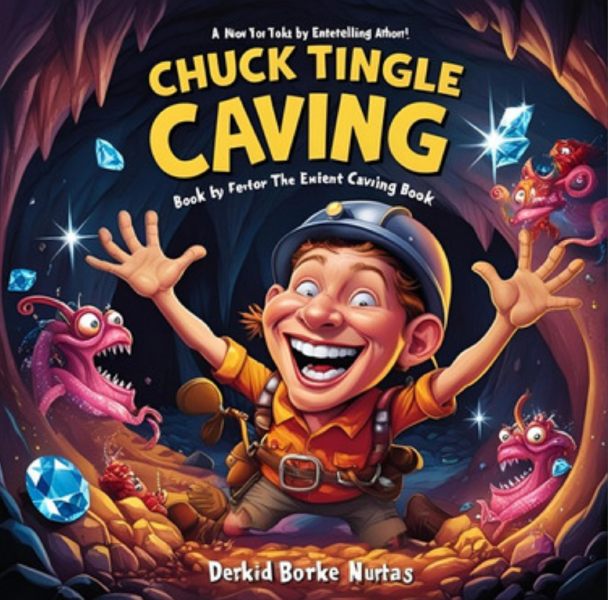
And that's exactly what we got. The words 'be careful what you wish for' spring to mind!
A plea for newsletter material unwisely included the word 'anything', so when one of our members kindly set to work creating the cover of a new Chuck Tingle adventure, naturally we had to publish it. See folks, this is what happens when you all go to ground and don't type up something more sensible instead!
If you're not familiar with the various adventures of Chuck Tingle (if you are, we dare you to admit it ...) Wiki has a handy explanation, however, enter at your peril.
And if anyone would like to write the first few paragraphs of a Chuck Tingle novel, we might publish that, too!
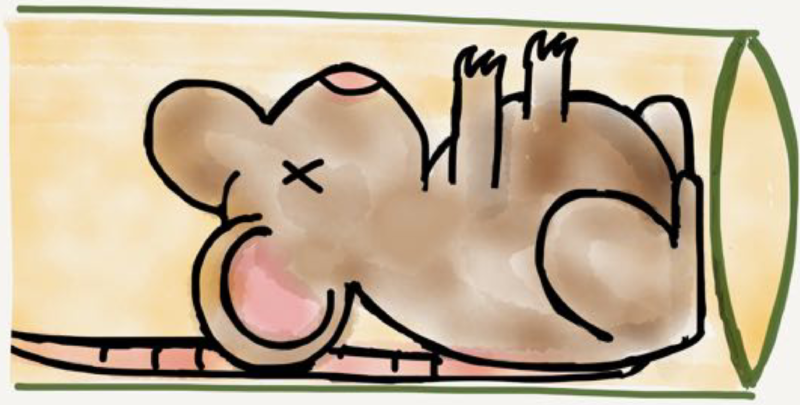
A mouse in a bottle. Illustration by Cayley Howard.
... a bottle of oil was left on a shelf in the Hut. Some of you may have heard this story while sitting around the fireside. Others may not have been so (un)lucky. Read on to learn how a legend was born..
One day, a bottle of oil was left behind after a weekend at the hut. ("Surely some mistake," cry the audience.) Then, some time later, an unfortunate mouse met an oily fate. When the hut was next visited, a fierce argument raged between those who wanted to clean the kitchen and remove all trace of the sad occurrence whilst others gleefully planned to leave the bottle of oil and its furry contents to terrorise unsuspecting freshers. We'll leave it to you, dear audience, to decide which faction won the day.
And so Oily Mouse remained on a shelf in the corner of the kitchen, preserved as a salutary warning of the dangers of leaving bottles of oil lying around. Years passed and freshers grew up with Oily Mouse, but then, horror of horrors, oil was found all over the kitchen, and Oily Mouse had disappeared, leaving behind an empty bottle with a hole chewed out of one corner and so the legend of Zombie Oily Mouse was born.
Remember this story when you're trying to get to sleep in the hut, as you close your eyes and listen in trepidation for a slither above you on the roof or maybe on the floor, or the sound of something sliding down your tent flap and landing with a little splutch on the leaves ...
A recent report of oil on one of the bunks attests to the truth of this tale and proves that when you're at the hut, you're never far from Zombie Oily Mouse!
Reference: Zombie Mice on Mendip in UBSS Newsletter, Series 3, no 19.
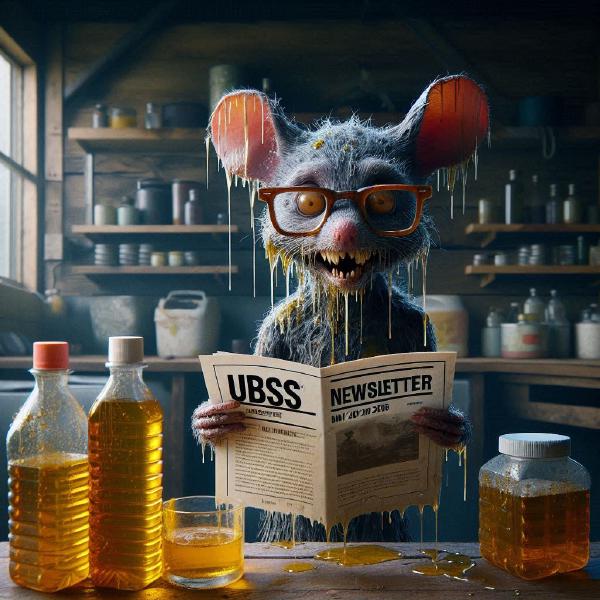
Did you? If so, drop us a line from the link (in blue), or be forever haunted by the pitter-patter of tiny oily paws! All the lovely folk who pander to us in this section will be in the mouse's good books ... for now at least ...
- I've been to Burwalls! Love the find in Longwood, good work. I enjoyed felling many trees there with SWT, ash dieback is bad, wear a helmet. [Merryn Matthews]
- Hola Señor Comadreja! I read to the end! Great write-up of the Dales trip. It really was a wonderfully faff-free weekend! [Paul Savage]
- Another excellent newsletter, particularly well done Elaine for such a terrifying run:) [Kat Osei-Mensah]
- Elaine ... soooo impressive! [Chris Howes]
- An excellent newsletter. focused, currently informed and right on. [Pete Smart]
- Thanks for the latest UBSS newsletter. Great as ever. [Andy Farrant]
- I read the story about the cave in the Avon Gorge. Guess where I was last week… Not suitably attired, but at least with a helmet! [Hans Friederich]
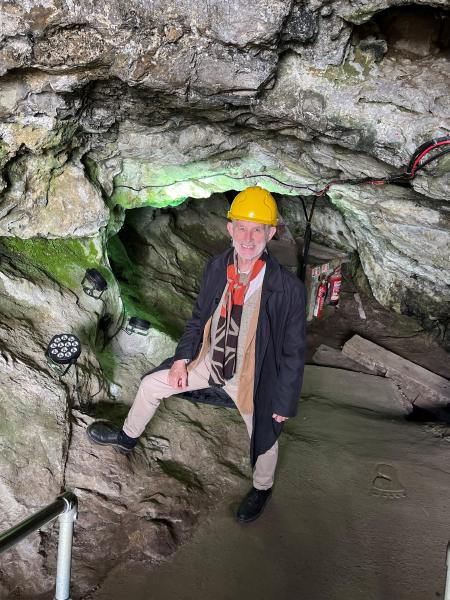
- Love the sunset header pic. [Elliott McCall]
- Probably my quickest newsletter read so had to send an email to mark it! [Dan Runcan]
- Watson Weasel is gorgeous; I want to bring him home with me! Perhaps Newsletter is spelt with three T's in Weaselese! Superb newsletter, as always. The Yorkshire trip sounded wonderful, and the swimming looked amazing. The condition of Longwood Valley is very sad! And Elaine Oliver is MUCH fitter, and a LOT braver than I am to have taken on that marathon! [Jan Walker]
Darling mousie, we worship at your shapely oily paws ...
THE END
